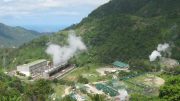Geothermal energy has a lot of applications today and can be a cost-effective way to generate heat.
We can consider thermal energy as the energy that encloses the Earth in the form of heat, and that is produced mainly in the disintegration of radioactive substances from their nucleus. This heat tends to diffuse inside until it escapes through the surface of the earth’s crust.
This energy would be enough to cover the world’s needs if it could be used, but geothermal energy is an energy that is difficult to use.
The temperature is distributed irregularly according to the zones of the earth’s crust. The bags of magma that come from the deeper areas move towards areas of lower pressure.
At its contact, the rocks melt, and it releases large amounts of gases that tend to escape through cracks and fissures in the crust, giving rise to volcanic phenomena such as volcanic eruptions, high-temperature gas outputs, hot water outlets (hot springs), etc. although only some of these are usable.
Man has been using geothermal energy since remote times. Nowadays, we try to find a way to take advantage of this immense amount of energy that encloses the earth in the form of heat and that, except in isolated cases, is wasted or lost.
In areas that we could call privileged (Iceland or parts of Italy), the use of geothermal energy can be made at various temperatures.
Low Temperature: The heat that emerges at less than 100 ºC is used directly in multiple applications such as heating, hot domestic and sanitary water, swimming pools, greenhouses, drying rooms, and much more.
This use presents an important drawback. Due to the low thermal level of the fluid, it has to be used in direct heat applications, so the consumption center must be close to the deposit.
Medium and High Temperature: To extract the energy stored in the lithosphere, we need the presence of an intermediate geothermal fluid (ammonia or freon) that acts as a transport vehicle of energy.
Once the geothermal fluid has reached the surface, it must undergo a series of transformations for its use. Geothermal fluids with a temperature higher than 150 ºC are used for the direct production of electricity through different types of cycles.
If the temperature is between 100 and 150 ºC, the use of this energy can be made in industrial processes.
At present, the research lines are aimed at carrying out geothermal energy transformation projects at low temperature with smaller investments and less deep soundings with fewer geological risks and problems of exploitation and business assembly.
Uses of geothermal energy
To determine its energy use, it is necessary to differentiate between geothermal energy of high temperatures and low temperatures. Its difference lies in the earth’s depth in each of them and its temperature.
In the first case, high temperatures are about three- or four-kilometers underground, and in the second case, it is found in the most superficial terrestrial layers. The temperature diversity of geothermal resources allows a large number of possibilities of use:
- High Temperature: More than 150 ºC. It allows for the transformation of water vapor into electrical energy directly.
- Average Temperature: Between 90 and 150 ºC. It can produce electrical energy using an exchange fluid, which is what feeds the power plants.
- Low Temperature: Between 30 and 90 ºC. Its heat content is insufficient to produce electrical energy, but it is suitable for heating buildings and in certain industrial and agricultural processes.
- Very Low Temperature: Less than 30 ºC. It can be used to obtain hot water for heating and air conditioning. In this case, you need to use heat pumps.
The geothermal plant of Nesjavellir in Iceland is a good example of how the heat of the earth is used to cover the hot water needs of the Greater Reykjavik metropolitan area. In Spain, we also find many examples of buildings in different Autonomous Communities where geothermal energy is used for applications such as underfloor heating or air conditioning.
This type of energy represents, without a doubt, a local, ecological, and efficient response to reduce energy costs.
Advantages of geothermal
Free and Inexhaustible Energy: We are masters of our energy to heat and cool the house. We do not depend on any other fuel or the swings in prices. Yes, the energy of the land is free and inexhaustible, but it is necessary to take into account the maintenance costs, in addition to the initial installation investment.
Renewable and Clean: It is an excellent environmental option since it is a source of clean energy, which does not emit CO2 or contribute to climate change. It does not work with combustion, and only the geothermal pump uses electricity.
There is also no need to worry about toxic gases such as carbon monoxide or possible fires.
Savings: A geothermal installation means savings of 75% in heating and approximately 80% in cooling. When starting from a stable temperature of 15º, cooling or heating the water is cheaper.
But you have to count on the electrical cost of the geothermal pump in this case.
Quick Amortization: By not having to pay for fuel, the investment is recovered in a few years and more if we take into account that we get heating, air conditioning in summer and also hot water. From the first month itself, we can expect to start saving substantially on the energy bill and the periods of return on investment vary significantly, depending on the energy demand of the home (heating, air conditioning, and hot water).
Without Environmental Impacts: It does not produce annoying noises or visual impacts on the landscape since the entire installation is buried.
Duration: A geothermal pump lasts up to twice as long as a conventional thermal boiler and spends little electricity.
Adaptable: Although it is more efficient if combined with underfloor heating, it is not necessary to install this system to enjoy the heat at home. It is possible to use the previously installed radiators too. After a study of the needs of each household, a specialized company can advise an extra installation in some cases.
Thermal energy comes with a lot of promise and is a clean and sustainable form of energy. Therefore, harnessing this energy to our advantage is not just cost-effective but also eco-friendly.
July 30th, 2019
Written by Kashyap Vyas
This article was originally published on Interesting Engineering. Read the original article.





